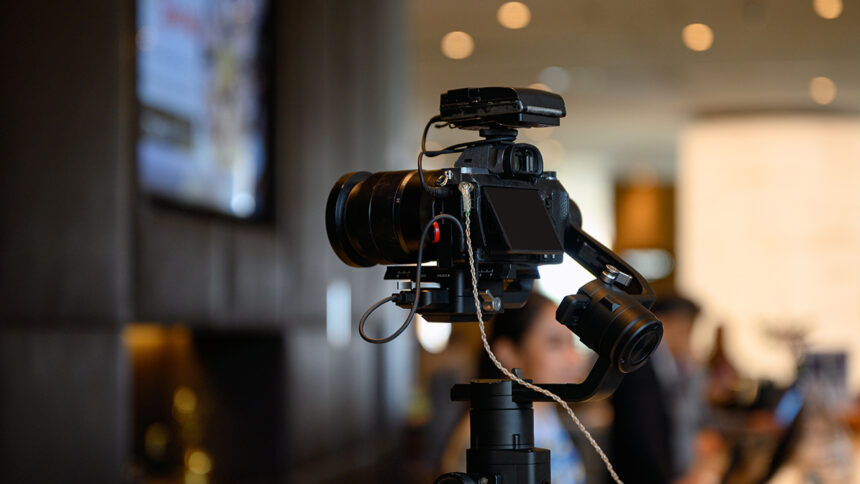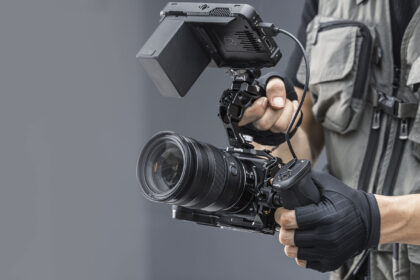Video stabilisation is one of the most important skills for today’s creators. Whether you’re shooting cinematic B-roll, vlogging your daily adventures, or filming professional client work, your stabiliser will determine how smooth and polished your video looks. But when it comes to choosing between a gimbal and a tripod, many beginners and even experienced videographers get confused.
- Introduction to Video Stabilizers
- Gimbal vs Tripod: What’s the Difference?
- Is a Gimbal Better Than a Tripod for Video?
- Pros and Cons of Gimbals
- Pros and Cons of Tripods
- Gimbal or Tripod for iPhone and Smartphone Filmmaking?
- Gimbal vs Tripod for Vlogging
- How to Choose the Right Gimbal
- How to Choose the Right Tripod
- Do Professional Filmmakers Use Gimbals?
- Gimbal or Tripod? How to Make the Final Decision
- FAQs
- Conclusion
In this detailed guide, we’ll compare both tools side-by-side and help you decide which stabiliser is right for your needs. If you’re a smartphone filmmaker, YouTuber, beginner creator, or professional videographer, this breakdown will simplify your decision and help you upgrade your shooting style with the right equipment.
For more gear designed to support your camera setup, you can explore mounts, tripods, stabilisers and accessories at CameraHolder.com — a platform dedicated to helping creators shoot with stability and confidence.
Introduction to Video Stabilizers
The need for stable video has grown massively with the rise of YouTube, Instagram Reels, TikTok, and professional videography. Shaky footage not only feels amateur but can take away from the story you’re trying to tell. This is why stabilisers, such as gimbals and tripods, are essential tools for every creator.
In this guide, we’ll answer the common question: Gimbal or Tripod? How to Choose the Right Stabilizer for Video, while helping you understand how each tool works, when to use them, and which one suits your content style.
Gimbal vs Tripod: What’s the Difference?
Before choosing the right stabiliser, it’s important to understand what each tool does and the benefits it provides.
What Is a Gimbal?
A gimbal is a motorised stabilisation device that helps keep your camera level and stable, even while moving. It uses either 2-axis or 3-axis motors to counteract unwanted shake, resulting in smooth motion shots.
Gimbals are perfect for:
- Walking shots
- Tracking shots
- Vlogs
- Run-and-gun filmmaking
- Cinematic movement sequences
- Smartphone videography
They are widely used by YouTubers, filmmakers, wedding videographers, and content creators who need stabilisation on the move.
What Is a Tripod?
A tripod is a three-legged stand that keeps your camera completely still. It is a classic stabilisation tool used for stationary video work.
Tripods are ideal for:
- Interviews
- Talking-head videos
- Product shots
- Real estate walkthroughs (static angles)
- Long exposure photography
- Timelapses
- Recording yourself without holding the camera
Unlike gimbals, tripods provide a stable base that doesn’t move unless you physically reposition them.
Quick Comparison Table: Gimbal vs Tripod
| Feature | Gimbal | Tripod |
|---|---|---|
| Stabilisation | Motorised, dynamic | Static, stable |
| Best Use | Moving shots | Still shots |
| Portability | Compact, lightweight | Varies (travel vs heavy) |
| Learning Curve | Moderate | Easy |
| Battery Required | Yes | No |
| Ideal For | Filmmakers, vloggers, creators | Youtubers, interview setups, stationary frames |
Is a Gimbal Better Than a Tripod for Video?
Short Answer:
A gimbal is better for dynamic movement shots, while a tripod is better for static and stable recordings. The “better” choice depends on your shooting style.
If your content involves walking, panning, following a subject, or movement-heavy footage, a gimbal gives you smoother results. If you need steady locked shots for interviews, product videos, or long recordings, a tripod is unbeatable.
Pros and Cons of Gimbals
Advantages
- Provides smooth cinematic motion
- Ideal for travel and vlogging
- Tracks subjects automatically (many models)
- Works great for phone and mirrorless cameras
- Lightweight and portable
Disadvantages
- Requires batteries
- Learning curve to master
- Not practical for long static shots
- Can be costly for high-end models
Gimbals are an excellent choice if you want a modern stabiliser capable of smooth, creative shots.
Pros and Cons of Tripods
Advantages
- Extremely stable
- No battery required
- Perfect for long static shots
- Great for interviews and talking-head videos
- Budget friendly
- Easy to use
Disadvantages
- Not designed for movement
- Can be bulky
- Slow to reposition in dynamic environments
Tripods remain a must-have tool for creators who want absolute stability.
Gimbal or Tripod for iPhone and Smartphone Filmmaking?
Smartphone creators often ask: Gimbal or tripod for iPhone? The answer depends on the type of videos you shoot.
Best Situations to Use a Smartphone Gimbal
Use a gimbal if you want:
- Smooth walking shots
- Cinematic movement
- Travel videos
- Action sequences
- Creative transitions
A gimbal stabilizer can turn an iPhone into a mini filmmaking setup.
Best Situations to Use a Smartphone Tripod
Use a tripod if you are:
- Filming yourself talking
- Doing tutorials
- Shooting product videos
- Recording stationary B-roll
- Filming long sessions hands-free
A Gimbal Tripod for Phone (a hybrid mini model) can also offer dual functionality if you prefer flexibility.
Gimbal vs Tripod for Vlogging
For vloggers, mobility is everything. If you’re constantly moving, switching angles, or recording your daily life on the go, a gimbal is the better choice.
A tripod, however, is perfect for:
- Desk vlogging
- Cooking vlogs
- Interview vlogs
- Static scenes
Some vloggers use both: a tripod at home and a gimbal for outdoor storytelling.
How to Choose the Right Gimbal
Choosing the right gimbal depends on a few key factors.
Key Factors to Consider
- Payload Capacity: Ensure it can support your phone or camera.
- 3-Axis or 2-Axis: 3-axis provides much smoother stabilisation.
- Battery Life: Longer battery life for full-day shoots.
- Compatibility: Works with smartphones, mirrorless cameras, or DSLRs.
- App Features: Tracking, timelapse modes, slow motion modes.
- Portability: Ideal for travel and run-and-gun shooting.
Who Should Choose a Gimbal?
- Filmmakers
- YouTubers
- Travel creators
- Content creators shooting motion-heavy videos
A gimbal elevates your dynamic shots and helps you create professional-grade movement.
How to Choose the Right Tripod
A tripod may seem simple, but choosing the right one matters.
Key Factors to Consider
- Height Range: Choose one that fits your shooting style.
- Weight Capacity: Must support your camera safely.
- Tripod Head Type: Fluid head for video, ball head for photography.
- Material: Aluminium for budget, carbon fibre for lightweight stability.
- Portability: Travel tripods are best for creators on the move.
Who Should Choose a Tripod?
- Interview creators
- Talking-head YouTubers
- Product videographers
- Landscape filmmakers
- Beginners who want simple stability
Tripods are essential in any camera kit, no matter your skill level.
Do Professional Filmmakers Use Gimbals?
Yes, professional filmmakers regularly use gimbals.
They are used for:
- Tracking shots
- Smooth movement scenes
- Cinematic reveals
- Push-in and pull-out shots
- High-quality commercial video
Even Hollywood productions use advanced gimbal systems. A good gimbal adds cinematic smoothness that would otherwise require heavy gear.
Gimbal or Tripod? How to Make the Final Decision
Both tools serve different purposes, so the right choice depends on your style and needs.
Choose a Gimbal If:
- You shoot movement-heavy content
- You love cinematic motion
- You vlog outdoors
- You want a compact travel stabiliser
- You film run-and-gun content
Choose a Tripod If:
- You film talking-head videos
- You record tutorials or product demos
- You need long, steady recording sessions
- You want a beginner-friendly stabiliser
- You shoot static video
When Should You Use Both?
Many creators use both simultaneously:
- Tripod for static shots
- Gimbal for moving footage
This hybrid setup gives you maximum control over your content.
FAQs
Is a gimbal better than a tripod for video?
A gimbal is better for moving shots, while a tripod is better for static shots. Both serve different purposes.
Which is better, a gimbal or a stabilizer?
Gimbals are motorised stabilisers. They offer smoother results than manual stabilisers but require batteries and practice.
How do I choose the right gimbal?
Check the payload support, battery life, app features, and compatibility with your camera or phone.
Do professional filmmakers use gimbals?
Yes. Gimbals are widely used in professional shoots for smooth cinematic movement.
What stabilizer is best for iPhone video?
A 3-axis smartphone gimbal is usually the best for dynamic shots. A tripod works best for still shots.
Can I use a gimbal as a tripod?
Some gimbals have mini tripod attachments, but they are not a replacement for a full tripod.
Is a gimbal worth it for beginners?
Yes, especially if you want smooth, cinematic motion for vlogs, travel videos, and creative content.
Conclusion
Choosing between a gimbal and a tripod depends entirely on your style of shooting. Gimbals are excellent for movement, dynamic storytelling, and modern filmmaking, while tripods are essential for stability, stationary shots, and long recordings. Most creators eventually benefit from owning both.
If you’re looking for reliable, high-quality camera support gear, check out CameraHolder.com, where you’ll find holders, mounts, tripods, stabilisers, and add-ons designed for creators of all levels.




